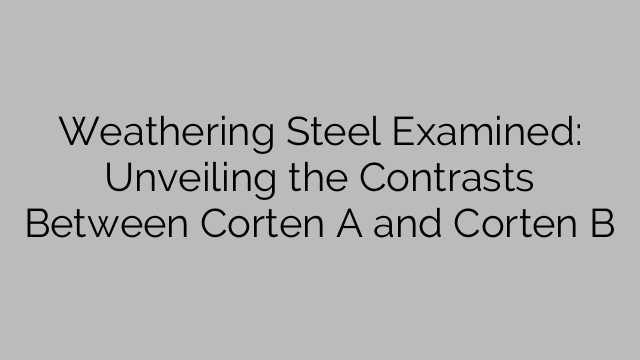First, let’s delve into what weathering steel is and why it has become so popular. Weathering steel is a high-strength, low-alloy steel known for its ability to resist corrosion. Unlike traditional steel, which tends to rust and deteriorate over time, weathering steel forms a protective layer of rust-like coating when exposed to the elements. This layer acts as a barrier and prevents further corrosion, contributing to the material’s exceptional durability.
Now, let’s turn our attention to Corten A and Corten B. Both grades of weathering steel offer similar properties, such as enhanced resistance to atmospheric corrosion, ensuring longevity and low maintenance requirements. However, there are some contrasting features that set them apart.
Corten A is the most commonly used type of weathering steel, primarily due to its excellent resistance to atmospheric corrosion. It typically contains a higher percentage of copper, chromium, and nickel, which enhances its ability to withstand exposure to various weather conditions. Corten A is often utilized in outdoor sculptures, architectural facades, and even bridges, thanks to its remarkable aesthetics and prolonged lifespan.
On the other hand, Corten B offers slightly different characteristics that make it suitable for specific applications. Unlike Corten A, Corten B contains a higher percentage of phosphorus, which enhances its resistance to corrosive elements such as sulfur dioxide gas and acidic rainwater. This feature makes Corten B an ideal choice for environments with a higher concentration of pollutants. Additionally, Corten B has a slightly higher tensile strength, which may offer advantages in certain structural applications.
When it comes to appearance, both Corten A and Corten B will develop a rust-like patina over time, providing a unique and textured look. However, there may be slight variations in the color and texture of the patina due to differences in the composition of the two grades.
Choosing between Corten A and Corten B ultimately depends on the specific requirements and conditions of your project. If your project is primarily exposed to general atmospheric conditions, Corten A would be a suitable choice, offering excellent resistance to corrosion. On the other hand, if your project is situated in an environment with higher levels of pollutants or corrosive elements, Corten B might be the more appropriate option.
In conclusion, weathering steel, or Corten steel, is a remarkable option for architects and designers looking for a durable and aesthetically appealing material. Both Corten A and Corten B offer exceptional corrosion resistance and develop a unique rust-like appearance over time. By understanding the contrasts between the two grades, you can make an informed decision and ensure that your project thrives in any weather condition.
[ad_2]

